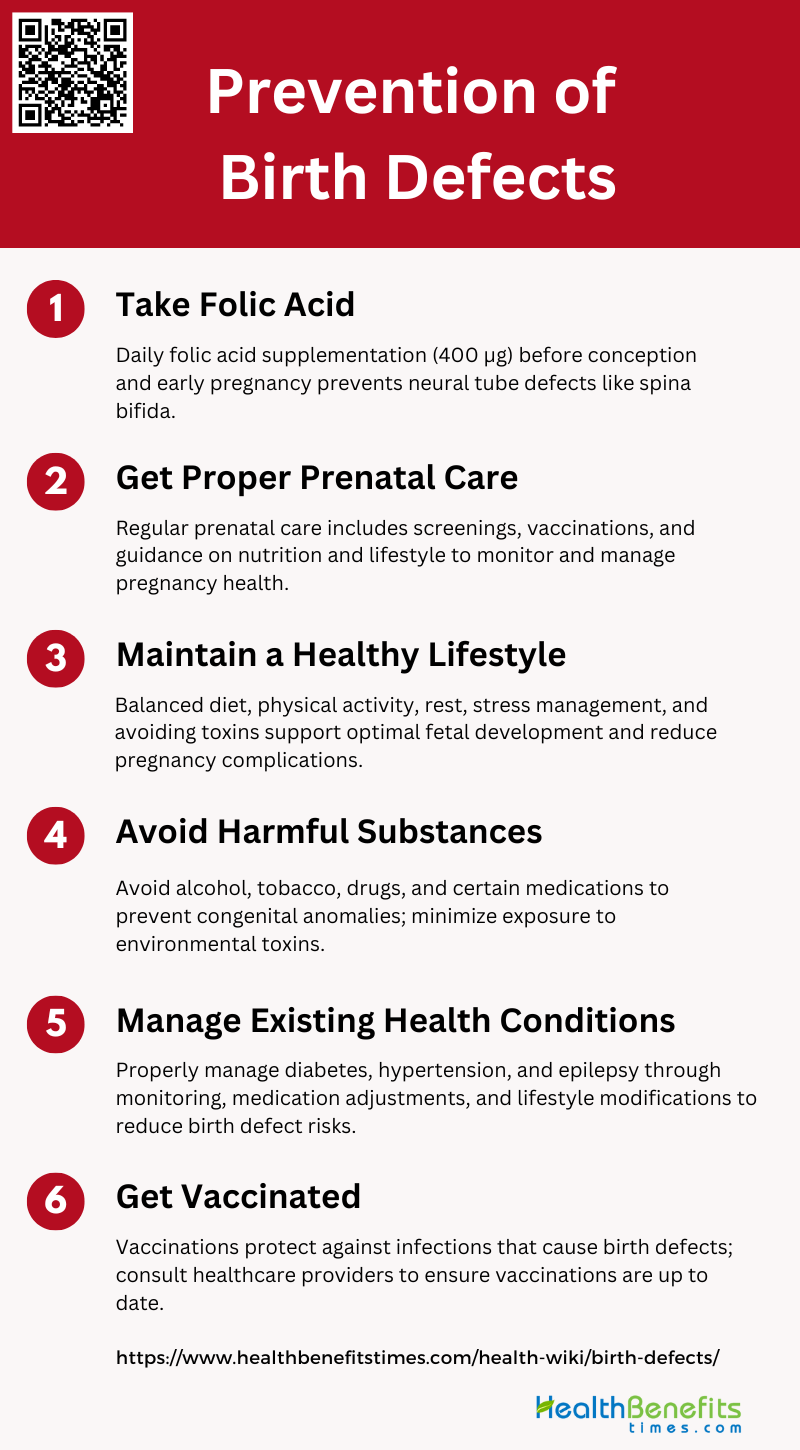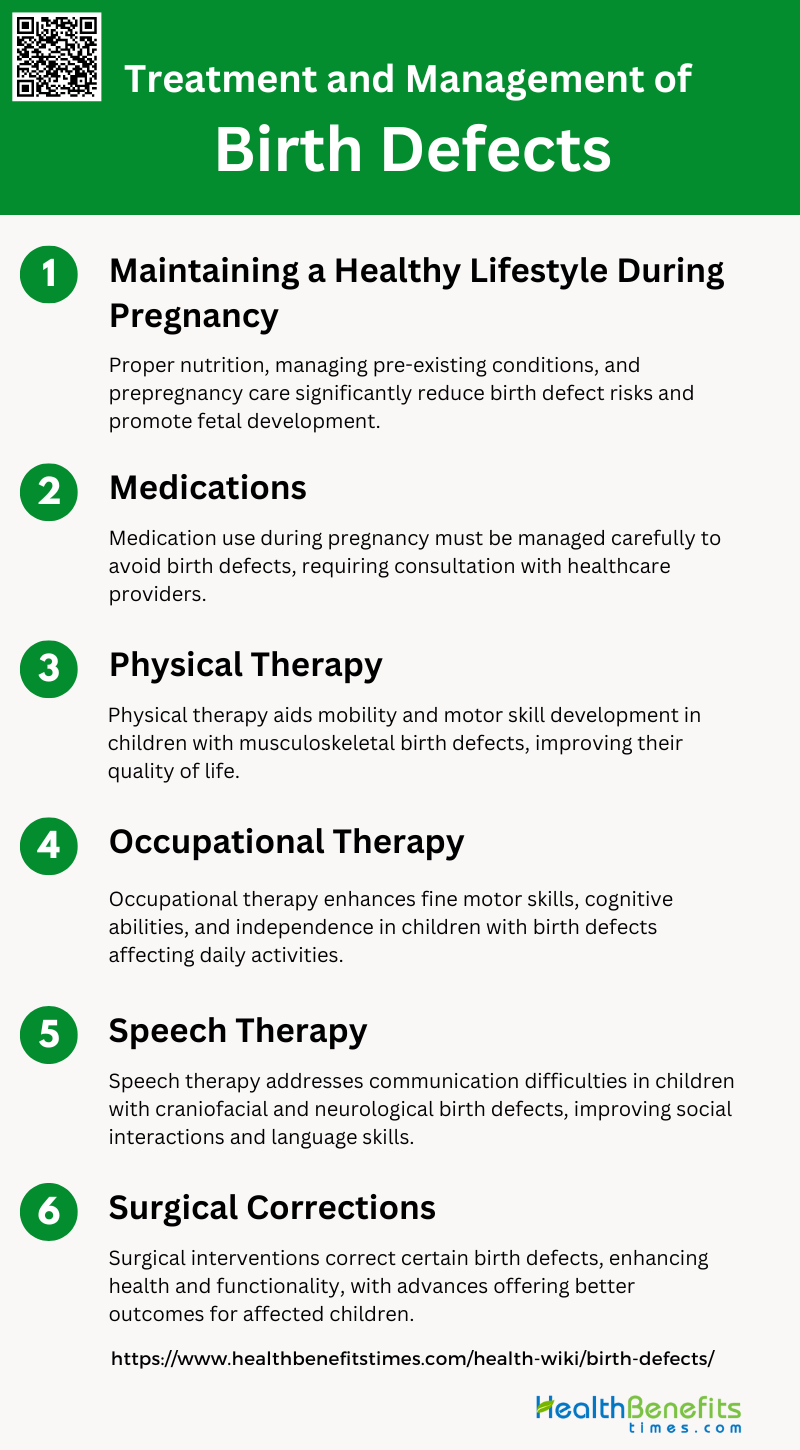Birth defects are structural or functional abnormalities present at birth that can affect any part of the body. These conditions develop during pregnancy and may be caused by genetic factors, environmental influences, or a combination of both. Birth defects can range from mild to severe and may impact a child’s physical appearance, organ function, or cognitive development. Common examples include congenital heart defects, neural tube defects, and chromosomal abnormalities like Down syndrome. The prevalence of birth defects varies globally, with recent estimates suggesting a birth prevalence of 9.410 per 1,000 live births for congenital heart defects alone. While some birth defects can be prevented through measures such as folic acid supplementation, many remain challenging to predict or prevent, highlighting the importance of ongoing research and prenatal care to improve outcomes for affected individuals.
Types of birth defects
Birth defects are abnormalities that occur during the development of a fetus. They can affect the structure or function of various body parts and systems. Understanding the different types of birth defects is crucial for early diagnosis and treatment. Here are the main two types of categories:
1. Structural Birth Defects
Structural birth defects are physical abnormalities that occur when certain body parts do not form properly during fetal development. These defects can affect almost any part of the body, including the heart, limbs, face, and nervous system. Common examples include neural tube defects, such as spina bifida, and orofacial defects like cleft lip and palate. Structural birth defects are often detected at birth and can result from genetic factors, environmental exposures, or a combination of both. For instance, studies have shown that maternal nutrition, exposure to teratogens, and genetic predispositions play significant roles in the development of these defects. The prevalence and types of structural birth defects can vary by region and population, highlighting the need for targeted prevention and intervention strategies.
2. Functional/Developmental Birth Defects
Functional or developmental birth defects involve problems with how a body part or system works. These defects may not be immediately apparent at birth but can become evident as the child grows. Examples include metabolic disorders, such as phenylketonuria (PKU), and developmental disorders like Down syndrome. Functional birth defects can result from genetic mutations, environmental factors, or a combination of both. For instance, gene-environment interactions have been shown to play a crucial role in the etiology of these defects, with maternal health, lifestyle, and exposure to environmental contaminants being significant contributors. Early diagnosis and intervention are critical for managing functional birth defects, as they can significantly impact a child’s quality of life and long-term health outcomes.
Causes of Birth Defects
Birth defects can arise from a variety of factors that affect fetal development. These factors can be genetic, environmental, or a combination of both. Understanding these causes is essential for prevention and early intervention. Here are the primary causes:
1. Genetic Factors
Genetic factors play a crucial role in the etiology of birth defects. These factors include chromosomal abnormalities, single-gene mutations, and multifactorial inheritance patterns. For instance, certain genetic characteristics of the embryo or fetus can predispose it to developmental abnormalities, such as neural tube defects and congenital heart defects. Advances in genomic research have identified specific genes and genetic pathways that are implicated in these defects. For example, haploinsufficiency of the Notch1 gene has been linked to congenital heart disease, particularly in the context of maternal diabetes. Additionally, genome-wide association studies have revealed that genetic variants associated with maternal glucose metabolism can influence the risk of neural tube defects. Understanding these genetic factors is essential for developing targeted prevention strategies and improving clinical outcomes.
2. Environmental Factors
Environmental factors significantly contribute to the risk of birth defects. These factors include exposure to teratogens such as prescribed and illicit drugs, environmental chemicals, and physical agents like radiation and hyperthermia. For example, maternal exposure to organic solvents, agricultural toxins, and drinking water contaminants has been linked to various birth defects, including neural tube defects and congenital heart defects. Additionally, infections such as Zika virus and chronic diseases like diabetes can adversely affect fetal development. The interplay between environmental exposures and genetic susceptibility further complicates the etiology of birth defects, making it essential to study these interactions to develop effective preventive measures.
3. Maternal Factors
Maternal factors, including health status, lifestyle, and genetic makeup, are critical determinants of birth defect risk. Maternal conditions such as diabetes and obesity have been shown to increase the risk of congenital anomalies, including neural tube defects and congenital heart disease. Lifestyle factors like smoking and occupational exposures to toxicants also contribute to the risk, with studies showing a significant association between paternal smoking and congenital heart defects. Nutritional deficiencies, particularly in folic acid, are well-documented risk factors for neural tube defects, highlighting the importance of maternal nutrition in fetal development. Understanding these maternal factors is vital for developing comprehensive public health strategies aimed at reducing the incidence of birth defects.
Detection and Diagnosis of Birth defects
Birth defects can arise from a variety of factors, often involving a complex interplay between genetic and environmental influences. Understanding these causes is crucial for prevention and early intervention. Below are some of the primary causes of birth defects:
1. Prenatal Screening
Prenatal screening for birth defects is a critical component of antenatal care, aiming to identify congenital anomalies early in pregnancy. Techniques such as maternal serum alpha-fetoprotein screening, ultrasound, and fetal magnetic resonance imaging are commonly used to detect structural anomalies like neural tube defects and congenital heart defects (CHD). High-throughput genomic sequencing, particularly whole exome sequencing (WES), has emerged as a powerful tool for diagnosing genetic disorders that traditional methods might miss. Non-invasive prenatal testing (NIPT) using cell-free DNA is also gaining traction for its high accuracy in detecting chromosomal abnormalities such as trisomies 13, 18, and 21. These advanced screening methods not only improve diagnostic accuracy but also provide parents with crucial information for making informed decisions about pregnancy management.
2. Postnatal Diagnosis
Postnatal diagnosis of birth defects involves a combination of clinical examination and advanced diagnostic tools to confirm and further investigate anomalies detected prenatally or those that manifest after birth. Pulse oximetry screening, for instance, is highly specific and moderately sensitive for detecting critical congenital heart defects (CCHD) in newborns, with a very low false-positive rate. Echocardiography remains a cornerstone for diagnosing CHD, allowing for detailed assessment of cardiac anatomy and function. The implementation of statewide newborn screening programs has significantly improved early detection rates, providing a safety net for cases missed during prenatal screening. Accurate postnatal diagnosis facilitates timely medical and surgical interventions, thereby reducing neonatal morbidity and mortality. Comprehensive follow-up and graded counseling based on the severity of detected anomalies further enhance the management and outcomes of affected infants.
Prevention of birth defects
Preventing birth defects involves a combination of healthy lifestyle choices, medical interventions, and awareness of potential risk factors. By taking proactive steps, expectant parents can significantly reduce the likelihood of birth defects. Below are some key strategies for prevention:
1. Take Folic Acid
Folic acid is crucial in preventing neural tube defects (NTDs) such as spina bifida and anencephaly. Studies have shown that daily supplementation with folic acid before conception and during early pregnancy significantly reduces the risk of NTDs. The recommended dose is 400 µg per day, which can be obtained from fortified foods, supplements, or both. This is particularly important for women of reproductive age, as many pregnancies are unplanned, and adequate folic acid levels are necessary from the very early stages of pregnancy.
2. Get Proper Prenatal Care
Proper prenatal care is essential for monitoring the health of both the mother and the developing fetus. Regular check-ups allow healthcare providers to identify and manage potential risks early on, such as infections that could lead to birth defects. Prenatal care includes routine screenings, vaccinations, and guidance on maintaining a healthy pregnancy. It also provides an opportunity for healthcare providers to educate expectant mothers on the importance of nutrition, lifestyle choices, and the avoidance of harmful substances.
3. Maintain a Healthy Lifestyle
Maintaining a healthy lifestyle during pregnancy can significantly reduce the risk of birth defects. This includes a balanced diet rich in essential nutrients, regular physical activity, and adequate rest. A healthy lifestyle supports optimal fetal development and reduces the risk of complications such as gestational diabetes and hypertension, which can adversely affect the pregnancy. Additionally, managing stress and avoiding exposure to environmental toxins are crucial components of a healthy lifestyle during pregnancy.
4. Avoid Harmful Substances
Avoiding harmful substances such as alcohol, tobacco, and illicit drugs is critical for preventing birth defects. These substances can interfere with fetal development and lead to a range of congenital anomalies, including NTDs and other serious conditions. Pregnant women should also be cautious with certain medications and consult their healthcare provider before taking any new drugs. Exposure to environmental toxins, such as pesticides and heavy metals, should be minimized to protect the developing fetus.
5. Manage Existing Health Conditions
Managing existing health conditions, such as diabetes, hypertension, and epilepsy, is vital for reducing the risk of birth defects. Proper management includes regular monitoring, medication adjustments, and lifestyle modifications as recommended by healthcare providers. Preconception counseling can help women with chronic conditions plan for a healthy pregnancy by optimizing their health status before conception. Effective management of these conditions during pregnancy can prevent complications that may adversely affect fetal development.
6. Get Vaccinated
Vaccination is an important preventive measure to protect against infections that can cause birth defects. Vaccines for influenza, pertussis, and other preventable diseases are recommended for women who are pregnant or planning to become pregnant. These vaccinations help protect both the mother and the developing fetus from serious infections that could lead to congenital anomalies. It is essential to consult with healthcare providers to ensure that all recommended vaccinations are up to date before and during pregnancy.
Treatment and Management of birth defects
Effective treatment and management of birth defects require a multidisciplinary approach tailored to the specific condition. Early diagnosis and intervention can significantly improve outcomes and quality of life for affected individuals. Below are some common strategies for treating and managing birth defects:
1. Maintaining a Healthy Lifestyle During Pregnancy
Maintaining a healthy lifestyle during pregnancy is crucial for reducing the risk of birth defects. Proper nutrition, including a diet rich in folate and other essential vitamins, is essential for fetal development and can prevent neural tube defects. Additionally, managing pre-existing conditions such as diabetes through strict glucose control and dietary management can significantly lower the incidence of birth defects. Prepregnancy care, which includes risk assessment and nutritional advice, is also vital for preventing congenital malformations. Overall, a healthy lifestyle during pregnancy can have a profound impact on the health of the baby.
2. Medications
The use of medications during pregnancy must be carefully managed to avoid potential birth defects. For instance, anti-tumor necrosis factor (anti-TNF) agents used to treat chronic inflammatory diseases have been associated with a slightly higher risk of birth defects, although the increase is not statistically significant. Hormonal treatments during the first trimester have also been linked to congenital heart defects, suggesting that such medications should be used cautiously. On the other hand, antiretroviral therapies like efavirenz (EFV) have been shown to be as safe as other ART drugs when used during conception and the first trimester. Therefore, medication management during pregnancy requires careful consideration and consultation with healthcare providers.
3. Physical Therapy
Physical therapy can play a significant role in the management of birth defects, particularly those affecting the musculoskeletal system. For children born with conditions like myelomeningocele, a type of neural tube defect, physical therapy can help improve mobility and function. Early intervention with physical therapy can also aid in the development of motor skills and reduce the severity of physical limitations. By incorporating physical therapy into the treatment plan, healthcare providers can enhance the quality of life for children with birth defects and support their physical development.
4. Occupational Therapy
Occupational therapy is essential for children with birth defects that impact their ability to perform daily activities. This type of therapy focuses on improving fine motor skills, cognitive abilities, and adaptive behaviors, enabling children to achieve greater independence. For instance, children with congenital heart defects may benefit from occupational therapy to enhance their developmental outcomes and manage any residual effects of their condition. By addressing the specific needs of each child, occupational therapy can help them overcome challenges and improve their overall functioning.
5. Speech Therapy
Speech therapy is crucial for children with birth defects that affect their communication abilities. Conditions such as cleft palate or other craniofacial anomalies can lead to speech and language difficulties. Early intervention with speech therapy can help these children develop effective communication skills and improve their social interactions. Additionally, speech therapy can be beneficial for children with neurological birth defects, such as those resulting from myelomeningocele, by addressing speech and language delays. Through targeted therapy, children can achieve better communication outcomes and enhance their quality of life.
6. Surgical Corrections
Surgical interventions are often necessary for correcting certain birth defects and improving the health and functionality of affected children. For example, open fetal surgery for neural tube defects like myelomeningocele has shown promising results in reducing the need for postnatal interventions and improving neurological outcomes. Similarly, surgical correction of congenital heart defects has enabled many affected individuals to survive to adulthood and lead healthier lives. Advances in fetal surgery and other surgical techniques continue to offer new possibilities for treating and managing birth defects, providing hope for better outcomes for affected children.
Living with Birth Defects
Living with birth defects presents unique challenges and requires ongoing support and adaptation. With the right resources and a supportive environment, individuals can lead fulfilling lives. Below are some key aspects of living with birth defects:
1. Early Intervention and Therapy
Early intervention and therapy are crucial for managing birth defects, particularly congenital heart diseases (CHD). Advances in ultrasound technology and fetal cardiac intervention (FCI) have enabled medical teams to diagnose and treat CHDs in utero, significantly improving outcomes. These early interventions can correct malformations while the tissues are still malleable, reducing morbidity and mortality both before and after birth. For instance, FCI has shown promising results in alleviating right ventricular dysfunction, leading to better postnatal adaptation and long-term function for children with CHD. Additionally, folate-oriented interventions during the periconception period have been effective in reducing the incidence of neural tube defects and other birth defects.
2. Support Systems
Support systems play a vital role in the lives of families dealing with birth defects. Social support has been linked to better long-term health outcomes, including improved immune function and reduced mortality. Parents of children with birth defects often face unique challenges, such as communication with healthcare professionals and finding appropriate resources. Effective support systems can include both professional and peer-provided interventions, which help parents integrate healthcare management into family life and maintain a sense of normality. These systems are essential for providing emotional and practical support, helping families navigate the complexities of medical care and daily life.
3. Coping Strategies
Coping strategies for parents of children with birth defects vary widely and are influenced by factors such as prior experience, social support, and personal beliefs. Common coping mechanisms include emotional responses, parental management, and avoidance strategies. Parents often strive to integrate the care of their child into their daily lives without letting it dominate, except during times of medical transition or hospitalization. Maintaining a sense of normality and calling on additional strategies or support during stressful periods are key to effective coping. Understanding these coping mechanisms can guide clinical services in providing better support to families.




